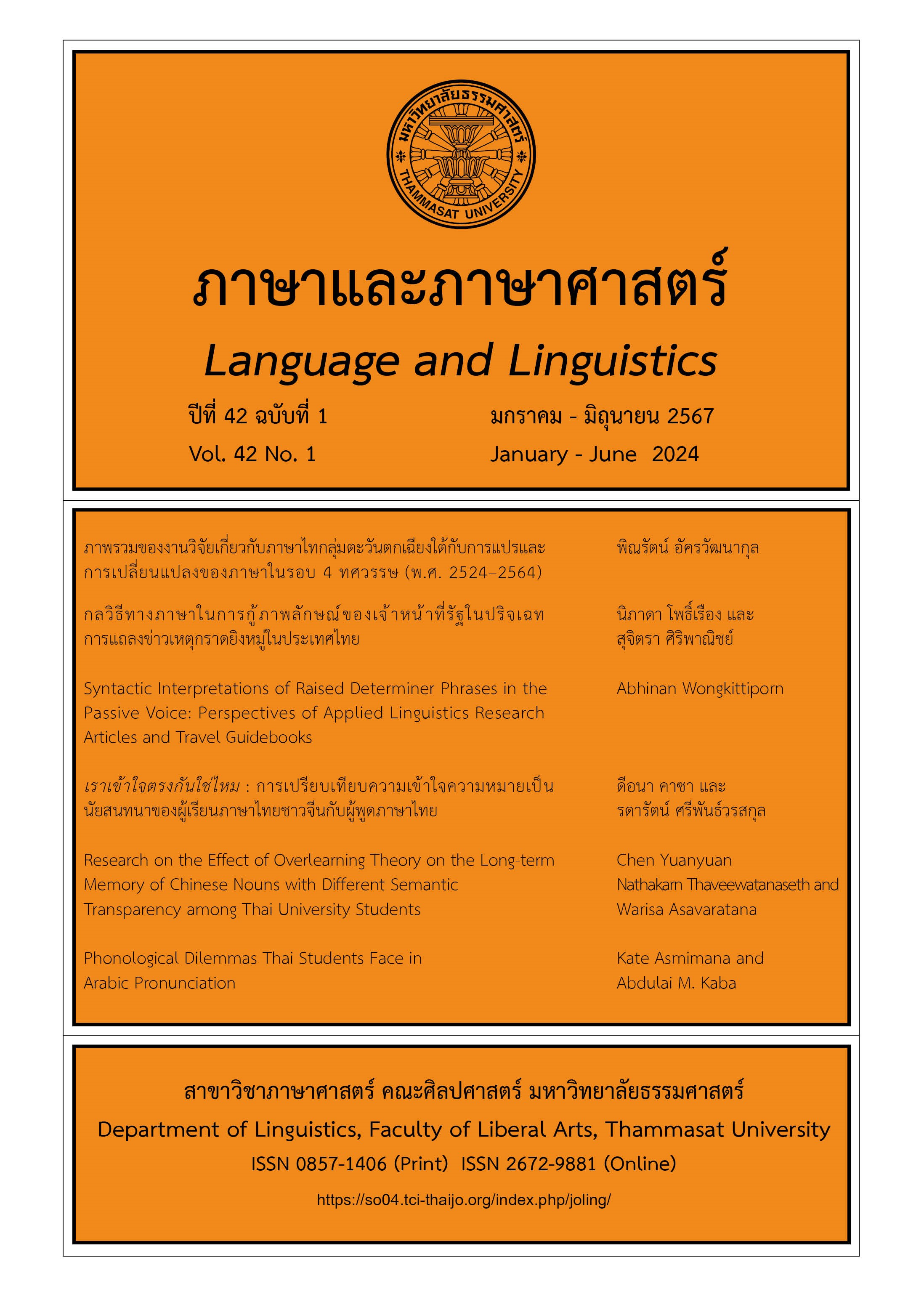กลวิธีทางภาษาในการกู้ภาพลักษณ์ของเจ้าหน้าที่รัฐในปริจเฉทการแถลงข่าวเหตุกราดยิงหมู่ในประเทศไทย
Main Article Content
บทคัดย่อ
บทความนี้มีวัตถุประสงค์เพื่อศึกษากลวิธีทางภาษาเพื่อกู้ภาพลักษณ์ในปริจเฉทการแถลงข่าวเหตุกราดยิงหมู่ในประเทศไทยของเจ้าหน้าที่รัฐจาก “เหตุกราดยิงหมู่ที่จังหวัดนครราชสีมา” และ “เหตุกราดยิงหมู่ที่จังหวัดหนองบัวลำภู” โดยใช้แนวคิดเรื่องการกู้ภาพลักษณ์ (Benoit, 1995, 1997, 2015) เป็นกรอบในการวิเคราะห์ ผลการศึกษาพบว่า เจ้าหน้าที่รัฐใช้กลวิธีทางภาษาในการแถลงข่าว และตอบคำถามสื่อมวลชนจำนวน 5 กลวิธี ได้แก่ 1. การปฏิเสธ 2. การลดความรับผิดชอบ 3. การลดข้อขุ่นข้องหมองใจ 4. การแสดงความยินยอมแก้ไข และ
5. การยอมรับผิดและการขอโทษ กลวิธีที่พบมากที่สุดคือ “การปฏิเสธ” ซึ่งกลวิธีย่อยประกอบด้วย 1) การปฏิเสธแบบตรง ๆ 2) การปฏิเสธแบบผลักความผิด และ 3) การปฏิเสธแบบให้ข้อมูลหักล้าง ในขณะที่กลวิธีที่ปรากฏน้อยที่สุดคือ “การยอมรับผิดและการขอโทษ” กลวิธีทางภาษาเหล่านี้ชี้ให้เห็นว่า ผู้แถลงข่าวซึ่งเป็นเจ้าหน้าที่รัฐมีความพยายามที่จะหักล้างภาพด้านลบที่เกิดขึ้นกับองค์กร และกู้ภาพลักษณ์คืนมา
Article Details

อนุญาตภายใต้เงื่อนไข Creative Commons Attribution-NonCommercial-NoDerivatives 4.0 International License.
บทความทุกบทความเป็นลิขสิทธิ์ของภาษาและภาษาศาสตร์
เอกสารอ้างอิง
กองบัญชาการกองทัพไทย. (2563). คู่มือการปลูกฝังอุดมการณ์ทางทหาร. สืบค้นเมื่อวันที่ 22 มกราคม 2566, จาก https://rtarf.mi.th/index.php/th/2016-06-23-07-14-54/2020-06-30-08-09-07/518-2020-07-14-03-21-44
ณัฐพร พานโพธิ์ทอง. (2555). เอกสารคำสอนรายวิชา 2201783 การวิเคราะห์ ภาษาไทยตามแนววัจนปฏิบัติศาสตร์ (ฉบับปรับปรุง). ภาควิชาภาษาไทย คณะอักษรศาสตร์ จุฬาลงกรณ์มหาวิทยาลัย.
ไทยรัฐออนไลน์. (11 กุมภาพันธ์ 2563). แถลงข้อเท็จจริงกรณีจ่าคลั่งกราดยิงที่โคราช. YouTube. https://www.youtube.com/watch?v=V-xy9cX2jTg
นราธร เนตรากูล. (12 ตุลาคม 2565). ส.ต.อ. ปัญญา คำราบ: ทำไม “คนดี” ของญาติจึงกลายเป็นมือสังหาร 36 คน. https://www.bbc.com/thai/articles/c8vgql0v4nmo
ประไพพรรณ พึ่งฉิม. (2560). ปริจเฉทการแถลงข่าวอื้อฉาวของบุคคลในวงการ บันเทิงไทย: การศึกษาเชิงปริจเฉทวิเคราะห์และวัจนปฏิบัติศาสตร์ [วิทยานิพนธ์ปริญญาดุษฎีบัณฑิต]. จุฬาลงกรณ์มหาวิทยาลัย.
ประไพพรรณ พึ่งฉิม. (2564). ตอบอย่างไรเมื่อประชาชนคนไทยเห็นว่ารัฐบาล “การ์ดตก”: กลวิธีการกู้ภาพลักษณ์ในปริจเฉทการแถลงข่าวของศูนย์บริหารสถานการณ์การแพร่ระบาดของโรคติดเชื้อไวรัสโคโรนา 2019 (โควิด-19). วารสารภาษาและวรรณคดีไทย, 38(2), 114-150.
มติชนทีวี. (6 ตุลาคม 2565). Live : ผบ.ตร แถลงข่าวโศกนาฏกรรม เหตุ #กราดยิงหนองบัวลำภู. YouTube. https://www.youtube.com/watch?v=7S0mFH8U7AI
สยามรัฐออนไลน์. (11 กุมภาพันธ์ 2563). เพจดังขยายความ'บิ๊กแดง'ยันทหารไม่มีวันยอมรับคนที่กราดยิงประชาชน. https://siamrath.co.th/n/132164
สำนักข่าวทูเดย์. (11 กุมภาพันธ์ 2563). “บิ๊กแดง” พล.อ.อภิรัชต์ คงสมพงษ์ ผบ.ทบ.แถลงเหตุ “กราดยิงโคราช”. YouTube. https://www.youtube.com/watch?v=z_tW5WjuW4c
สำนักงานตำรวจแห่งชาติ. (2555). ระเบียบสำนักงานตำรวจแห่งชาติ ว่าด้วยประมวลระเบียบการตำรวจไม่เกี่ยวกับคดี ลักษณะที่ 16 การส่งเสริมจริยธรรมและจรรยาบรรณของตำรวจ พ.ศ.2555 ลงวันที่ 26 กรกฎาคม พ.ศ.2555. https://drive.google.com/file/d/1PpRVK0rx3KOSPMWFdOKpl0LuoaCi-rD2/view?pli=1
อรวี บุนนาค. (2562). กลวิธีทางภาษาในการประกอบสร้างภาพลักษณ์องค์กรธุรกิจในภาวะวิกฤตผ่านเฟซบุ๊กองค์กร [วิทยานิพนธ์ปริญญาดุษฎีบัณฑิต]. มหาวิทยาลัยศิลปากร.
Ancarno, C. (2015). When are public apologies ‘successful’? Focus on British and French apology press uptakes. Journal of Pragmatics, 84, 139-153.
Austin, J. L. (1962). How to do things with words. Oxford University Press.
Benoit, W. L. (1995). Accounts, excuse and apologies: A theory of image restoration strategies. State University of New York Press.
Benoit, W. L. (1997a). Image repair theory and corporate reputation. In C. E. Carroll (Ed.), The handbook of communication and corporate peputation (pp. 213-221). John Wiley & Sons.
Benoit, W. L. (1997b). Image repair discourse and crisis communication. Public Relations Review, 23(2), 177-186.
Benoit, W. L. (1997c). Hugh Grant’s image restoration discourse: An actor apologizes. Communication Quarterly, 45(3), 251-267.
Benoit, W. L. (2015). Accounts, excuse and apologies: Image repair theory and research (2nd ed.). State University of New York Press.
Blum-Kulka, S., House, J., & Kasper, G. (1989). Cross-cultural pragmatics: Requests and apologies. Ablex Publishing Corporation.
Dardis, F., & Haigh, M. M. (2009). Prescribing versus describing: Testing image restoration strategies in a crisis situation. Emerald Insight, 14(1), 101-118.
Goffman, E. (1967). Interaction ritual: Essays on face-to-face behavior. Fakenham and Reading.
Grimmer, L. (2017). Is it so hard to say sorry? Revisiting image restoration theory in the context of Australian supermarkets. Asia Pacific Public Relations Journal, 18, 17-32.
Meng, J., & Pan, P. (2013). Revisiting image-restoration strategies: An integrated case study of three athlete sex scandals in sport news. International Journal of Sport Communication, 6(1), 87-100.
Searle, J. R. (1969). Speech acts: An essay in the philosophy of language. Cambridge University Press.
Zhang, J., & Benoit, W. L. (2004). Message strategies of Saudi Arabia’s image restoration campaign after 9/11. Public Relations Review, 30(2), 161-167.


